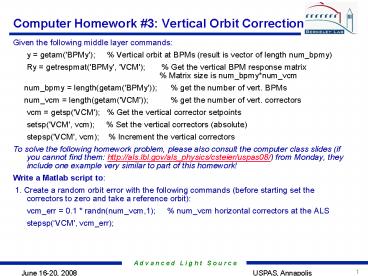Computer Homework - PowerPoint PPT Presentation
Title:
Computer Homework
Description:
Computer Homework #3: Vertical Orbit Correction. Given the following middle layer commands: ... num_bpmy = length(getam('BPMy')); % get the number of vert. BPMs ... – PowerPoint PPT presentation
Number of Views:49
Avg rating:3.0/5.0
Title: Computer Homework
1
Computer Homework 3 Vertical Orbit Correction
- Given the following middle layer commands
- y getam('BPMy') Vertical orbit at BPMs
(result is vector of length num_bpmy) - Ry getrespmat('BPMy', 'VCM') Get the
vertical BPM response matrix
Matrix size is num_bpmynum_vcm - num_bpmy length(getam('BPMy')) get the
number of vert. BPMs - num_vcm length(getam('VCM')) get the
number of vert. correctors - vcm getsp('VCM') Get the vertical
corrector setpoints - setsp('VCM', vcm) Set the vertical
correctors (absolute) - stepsp('VCM', vcm) Increment the vertical
correctors - To solve the following homework problem, please
also consult the computer class slides (if you
cannot find them http//als.lbl.gov/als_physics/c
steier/uspas08/) from Monday, they include one
example very similar to part of this homework! - Write a Matlab script to
- 1. Create a random orbit error with the
following commands (before starting set the
correctors to zero and take a reference orbit) - vcm_err 0.1 randn(num_vcm,1) num_vcm
horizontal correctors at the ALS - stepsp(VCM', vcm_err)
2
Homework 3 (continued)
- For the following parts remember for loops in
Matlab (gtgthelp for), as well as the possibility
to add new data to a vector (like
yrms(loop)std(gety) with loop being incrmented
in the for loop). - 2. Correct the orbit using various numbers of
SVs - a. Plot the singular values (i.e. the
diagonal elements of the matrix S after the SVD
inversion) of the response matrix (using
semilogy) - b. Plot the remaining RMS and Max orbit error
(std and max(abs)) vs. of the singular values
used in the orbit correction (the example in the
computer class used 48). - i.e., plot the orbit error when 1 sv is
used, 12 sv, 13 sv, 14 sv, etc. (up to
num_vcm) - Important Do not forget to remove previous
correction before applying new one! - c. Plot the total corrector strength change
(sum(abs(DeltaVCM))) as well as total strength
plus initial error (sum(abs(DeltaVCMvcm_err)))
vs. - of the singular values used.
- d. How many singular values would you
recommend using? - Now remove the random orbit error (removing what
you did in 1.) and only put one big error in, set
any of the VCMs for example to 1 A. - Repeat step 2. a-d above. Does the optimum
number of SVs change?































